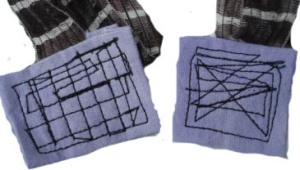I live not far from Hounslow, Middlesex. It is a mini-mini-mini Southall. By that I mean that it has a high Asian population and consequently a good few shops full of Asian goodies. One of these shops sells fabric, much of it with a great bling factor and even better than that there is usually some very cheap fabric to be had. The downside is that I never really NEED any such fabric but of course I can’t resist a rummage in the remnant bin or the purchase of “just one metre” of this and that. So it was that a few years ago I acquired this purple fabric.

If you look at the bottom of the photo you will see the front of the material. It really is a bit too much for me to think of anything to use it for and so it has languished in various bags, piles and heaps since it came home with me.
For a while I have been considering that the back of the fabric would be more useable even though those gold squiggles show through in places. My scissors first cut into two pieces that I sandwiched together with some wadding to make a cover for a notebook. I also sewed in two bookmarks made from wrapped yarn. I used a length of red yarn and machine wrapped it with red bobbin thread and blue top thread.
My second piece of purple playfulness was the unfinished clutch bag in the middle. I bought some bondaweb with the idea that being double-sided I could fuse it between two layers of the fabric and it would also give it some substance. I don’t know what I was thinking of because of course the bondaweb is so gossamer-like that once the two protective layers are removed there was no substance left. I probably should have abandoned the project there and then but I’m not like that. I enjoy messing around. So I picked up my second attempt at wrapped thread that had turned out to be what I grandly call “antique gold”. I then began to sew strips of this wrapped thread all over the cut out & sandwiched fabric pieces (one body +flap piece and two gussets). Soon they began to act rather like a corset and when I sewed the pieces together into the bag shape it was more or less self-supporting. Now I think that I will I have to line it somehow and I’ll probably use a double or triple length of the remaining wrapped thread for a strap (even though clutch bags don’t need a strap).
Moving on to the SOCK SILLINESS …

I have my father’s big toes. They seem to have a life of their own and though I don’t ever feel them at it, I know that they wriggle and jiggle all day inside my shoes. How else would I have one giant hole in each toe of nearly all of my socks. Yes, I do know how to darn and I do darn although most of my socks are a cotton mix and don’t accept a lot of darning or in my case, major reconstruction, as well as wool socks do. A week or two ago I was being all New Yearish and I emptied and sorted my sock drawer. I had no idea how many pairs of socks I had because quite honestly I ran out of fingers and toes (big or small) to count them on. I took a deep breath and decided to throw out all those socks that had darns on the darns or were in urgent need of such. The pile was mountainous and I just couldn’t bear to throw them out. I had several pairs of spotty, dotty socks and many with stripes. I have a weakness for both. So .. I cut off the damaged toes, the heels (which are the most three-dimensional part of the sock) and the cuffs. This resulted in two “tubes” per sock and I cut down each down the length resulting in a flat pirce of sock fabric. Then in a very haphazard way I zig-zagged the pieces together. Now what on earth have I ended up with …. a squilt? And what on earth do I do with this “squilt”?
Finally … on the left …. two more pieces of the fabric, right bright sides together. The flower’s centre made from a green foil wrapper from a chocolate (“borrowed” from the Loom Monkey’s magpie stash of “useful things”) and the orange petals machine embroidered. Finally I stitched a decorative machine-embroidered border around the edge of the piece sandwiching the two pieces of fabric together.




